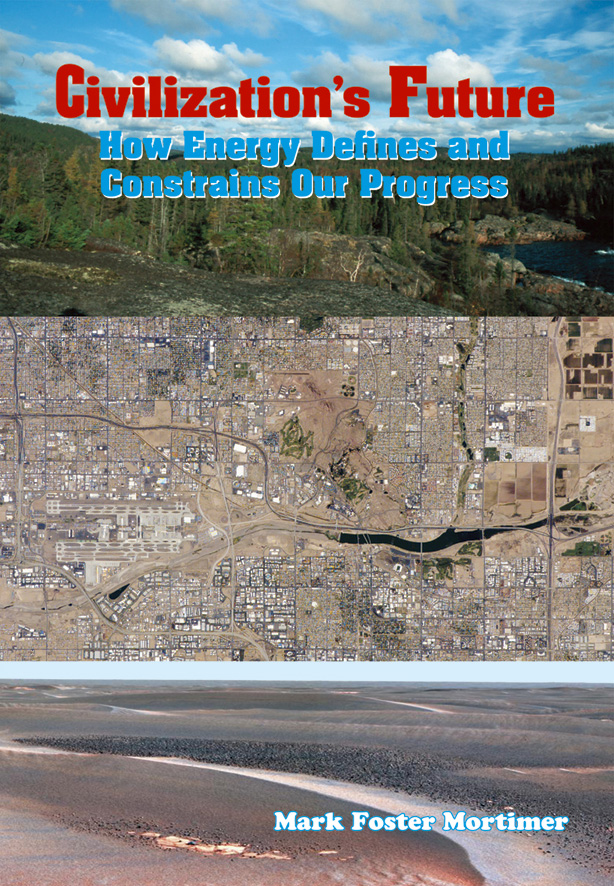With his book “Civilization’s Future”, Mark Mortimer shines a beacon. Though uncertainty shrouds humanity’s progress into tomorrow, we have confidence based upon our achievements of the past. Mortimer shows that energy was and is a critical parameter that defines what we’ve done and what we can do. In his book, Mortimer quantifies this and demonstrates how we can assign energy to define and attain a future that provides for people, their dreams and the survival of our fellow residents on Earth.
By focusing upon energy in Civilization’s Future, Mortimer connects humanity’s earliest civilizations to the extinction of dinosaurs and the Apollo space program. Further, in comparing our energy needs with the provisions of renewable energy sources he shows how we can achieve the future of our choice. In counterpoint though, he also considers possible consequences should we forego planning for the future.
From the Back Cover;
My greatest concern is that our actions today are so contrary to a better future. We have gone from living off the interest to rapaciously consuming all the natural capital of the Earth. We are preventing nature from maintaining or rebuilding. Thus future generations will have both much less energy and also a much poorer Earth from which to eke out a living. Our actions today are in the name of civilization but may be the death of civilization.
Excerpts
From Humans in the Garden;
Our genus Homo Sapiens Sapiens has basic energy requirements to stay alive. Any dieter could easily recite the necessary minimum. We can also estimate energy needs for typical lifestyles. Table 10 lists the average energy needs for today’s humans according to the British Nutrition Foundation. Appendix A provides more estimates on energy requirements.
From Sedentary Agrarians;
In all, Sargon held sway over most of Mesopotamia and adjacent regions for a total area of direct control of about 800 by 400 km or 320,000 square kilometres. Traders extended this sphere of influence as far east as the Indus valley and west to the Mediterranean, including Crete. We can estimate the overall energy expenditure for this group of people by determining their average energy needs and then multiplying by the number of people as shown in Table 24.
From Energy Assessment for Canada;
Data for personal use of energy or personal expenditures are not given by the OECD. We can assume that all the remaining GDP must fall into personal expenditure. In so doing, personal expenditure accounts for 47%. As this is reasonably close to the Canadian value, this assumption will do for our considerations. The complete allocation of relative amounts of energy for Information Man as typified by OECD countries is shown in Table 49.
From Future Energy Allocation;
Any given choice for the future relies on a supply of energy. Purely staying alive requires energy. We have consumed about half the known supply of petroleum that it is economically viable to extract. Let’s consider allocating the remnants. For convenience we will use a value of 1,000 billion barrels of oil or 5.72 x 1021 Joules remaining. The British Petroleum Annual Review states a value of 1,188 billion barrels for the end of 2003 but this value fluctuates from finding new reservoirs and recalculating old ones. Let’s consider allocations for this remaining petroleum.
Assuming everyone wants to maintain energy allocations as for an average person in the OCED, we would expect the energy to be divided as shown in Table 61. This indicates where we would allot energy in the future were we to maintain today’s divisions.
